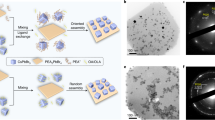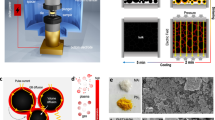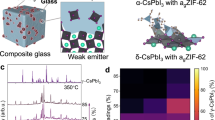Abstract
The kinetic Wulff shape, determined by the crystal structure and growth rates of different crystal facets, is ubiquitous in classical crystal growth. However, its utilization for heterostructure integration remains largely unexplored. Here we report the discovery of kinetic Wulff-shaped heteroepitaxial growth in halide perovskites, which enables the realization of well-defined phase-pure 2D halide perovskite epitaxial heterostructures with deterministic slab thickness (n = 1–3). This approach allows modulation of the interfacial lattice mismatch from 0% to >11%. Two-___domain and complex heterostructures synthesized using this approach have well-defined chemical compositions and electronic structures that may enable the development of ultranarrow domains (less than the de Broglie wavelength of carriers) for solution-processed lateral quantum wells and superlattices. Finally, devices based on these heterostructures demonstrate substantial rectification ratios and reliable switching behaviours under optical or electrical inputs. This study presents the universality of kinetic Wulff-shaped epitaxy in achieving 2D halide perovskite epitaxial heterostructures with high phase purity.

This is a preview of subscription content, access via your institution
Access options
Subscribe to this journal
Receive 12 digital issues and online access to articles
118,99 € per year
only 9,92 € per issue
Buy this article
- Purchase on SpringerLink
- Instant access to full article PDF
Prices may be subject to local taxes which are calculated during checkout




Similar content being viewed by others
Data availability
The X-ray crystallographic coordinates for structures reported in this study have been deposited at the Cambridge Crystallographic Data Centre (CCDC), under deposition numbers CCDC 2376612 for (3T)2PbI4, CCDC 2376613 for (3T)2MAPb2I7, CCDC 2376614 for (3T)2SnI4, CCDC 2376615 for (3T)2MASn2I7, CCDC 2376616 for (3T)2PbCl4 and CCDC 2376617 for (3T)2PbBr4. These data can be obtained free of charge from The Cambridge Crystallographic Data Centre via www.ccdc.cam.ac.uk/data_request/cif. The additional data that substantiate the study’s findings and contribute to the assessment of the paper’s conclusions can be accessed within the Article and its Supplementary Information. Source data are provided with this paper.
References
Artyukhov, V. I., Liu, Y. & Yakobson, B. I. Equilibrium at the edge and atomistic mechanisms of graphene growth. Proc. Natl Acad. Sci. USA 109, 15136–15140 (2012).
Nishinaga, T. Handbook of Crystal Growth: Fundamentals (Elsevier, 2014).
Markov, I. Crystal Growth for Beginners: Fundamentals of Nucleation, Crystal Growth and Epitaxy (World Scientific, 2017).
Vlassiouk, I. V. et al. Evolutionary selection growth of two-dimensional materials on polycrystalline substrates. Nat. Mater. 17, 318–322 (2018).
Wang, Y., Shi, Y., Xin, G., Lian, J. & Shi, J. Two-dimensional van der Waals epitaxy kinetics in a three-dimensional perovskite halide. Cryst. Growth Des. 15, 4741–4749 (2015).
Gao, M. et al. The making of a reconfigurable semiconductor with a soft ionic lattice. Matter 4, 3874–3896 (2021).
Jena, A. K., Kulkarni, A. & Miyasaka, T. Halide perovskite photovoltaics: background, status, and future prospects. Chem. Rev. 119, 3036–3103 (2019).
Zhu, H. et al. Lead halide perovskite nanowire lasers with low lasing thresholds and high quality factors. Nat. Mater. 14, 636–642 (2015).
Wei, W. et al. Monolithic integration of hybrid perovskite single crystals with heterogenous substrate for highly sensitive X-ray imaging. Nat. Photonics 11, 315–321 (2017).
Ji, R. et al. Perovskite phase heterojunction solar cells. Nat. Energy 7, 1170–1179 (2022).
Lei, Y. et al. Perovskite superlattices with efficient carrier dynamics. Nature 608, 317–323 (2022).
Lai, M. et al. Intrinsic anion diffusivity in lead halide perovskites is facilitated by a soft lattice. Proc. Natl Acad. Sci. USA 115, 11929–11934 (2018).
Pan, D. et al. Visualization and studies of ion-diffusion kinetics in cesium lead bromide perovskite nanowires. Nano Lett. 18, 1807–1813 (2018).
Akriti et al. Layer-by-layer anionic diffusion in two-dimensional halide perovskite vertical heterostructures. Nat. Nanotechnol. 16, 584–591 (2021).
Saparov, B. & Mitzi, D. B. Organic–inorganic perovskites: structural versatility for functional materials design. Chem. Rev. 116, 4558–4596 (2016).
Gao, Y. et al. Molecular engineering of organic–inorganic hybrid perovskites quantum wells. Nat. Chem. 11, 1151–1157 (2019).
Smith, I. C., Hoke, E. T., Solis‐Ibarra, D., McGehee, M. D. & Karunadasa, H. I. A layered hybrid perovskite solar‐cell absorber with enhanced moisture stability. Angew. Chem. Int. Ed. 53, 11232–11235 (2014).
Stoumpos, C. C. et al. Ruddlesden–Popper hybrid lead iodide perovskite 2D homologous semiconductors. Chem. Mater. 28, 2852–2867 (2016).
Leng, K. et al. Molecularly thin two-dimensional hybrid perovskites with tunable optoelectronic properties due to reversible surface relaxation. Nat. Mater. 17, 908–914 (2018).
Pan, D. et al. Deterministic fabrication of arbitrary vertical heterostructures of two-dimensional Ruddlesden–Popper halide perovskites. Nat. Nanotechnol. 16, 159–165 (2020).
Liang, C. et al. Two-dimensional Ruddlesden–Popper layered perovskite solar cells based on phase-pure thin films. Nat. Energy 6, 38–45 (2020).
Sidhik, S. et al. High-phase purity two-dimensional perovskites with 17.3% efficiency enabled by interface engineering of hole transport layer. Cell Rep. Phys. Sci. 2, 100601 (2021).
Lee, J.-W. et al. 2D perovskite stabilized phase-pure formamidinium perovskite solar cells. Nat. Commun. 9, 3021 (2018).
Shi, E. et al. Two-dimensional halide perovskite lateral epitaxial heterostructures. Nature 580, 614–620 (2020).
Lei, Y. et al. A fabrication process for flexible single-crystal perovskite devices. Nature 583, 790–795 (2020).
Zhang, L. et al. Thickness-controlled wafer-scale single-crystalline MAPbBr3 films epitaxially grown on CsPbBr3 substrates by the droplet-evaporated crystallization method. ACS Appl. Mater. Interfaces 12, 39834–39840 (2020).
Zhang, Z. et al. Robust epitaxial growth of two-dimensional heterostructures, multiheterostructures, and superlattices. Science 357, 788–792 (2017).
Sahoo, P. K., Memaran, S., Xin, Y., Balicas, L. & Gutiérrez, H. R. One-pot growth of two-dimensional lateral heterostructures via sequential edge-epitaxy. Nature 553, 63–67 (2018).
Xie, S. et al. Coherent, atomically thin transition-metal dichalcogenide superlattices with engineered strain. Science 359, 1131–1136 (2018).
Gong, Y. et al. Vertical and in-plane heterostructures from WS2/MoS2 monolayers. Nat. Mater. 13, 1135–1142 (2014).
Gao, Q., Sahin, H., Kang, J. & Wei, S.-H. Origin of anomalous band-gap bowing in two-dimensional tin-lead mixed perovskite alloys. Phys. Rev. B 104, 064204 (2021).
Burton, W., Cabrera, N. & Frank, F. The growth of crystals and the equilibrium structure of their surfaces. Philos. Trans. Royal Soc. A 243, 299–358 (1951).
Dong, J., Ding, D., Jin, C., Liu, Y. & Ding, F. Edge reconstruction-dependent growth kinetics of MoS2. ACS Nano 17, 127–136 (2022).
Liu, Y., Huang, Y. & Duan, X. Van der Waals integration before and beyond two-dimensional materials. Nature 567, 323–333 (2019).
Cheng, K. III–V Compound Semiconductors and Devices: An Introduction to Fundamentals (Springer, 2020).
Park, J. Y. et al. Thickness control of organic semiconductor-incorporated perovskites. Nat. Chem. 15, 1745–1753 (2023).
Makino, T. Analytical formulas for the optical gain of quantum wells. IEEE J. Quant. Electron. 32, 493–501 (1996).
Kelly, M. Quantum semiconductor devices. Sci. Progress 72, 99–116 (1988).
Castellanos-Gomez, A. et al. Deterministic transfer of two-dimensional materials by all-dry viscoelastic stamping. 2D Mater. 1, 2628 (2014).
Frisenda, R. et al. Recent progress in the assembly of nanodevices and van der Waals heterostructures by deterministic placement of 2D materials. Chem. Soc. Rev. 47, 53–68 (2018).
Liu, Y. et al. Van der Waals heterostructures and devices. Nat. Rev. Mater. 1, 16042 (2016).
Allain, A., Kang, J., Banerjee, K. & Kis, A. Electrical contacts to two-dimensional semiconductors. Nat. Mater. 14, 1195–1205 (2015).
Schulman, D. S., Arnold, A. J. & Das, S. Contact engineering for 2D materials and devices. Chem. Soc. Rev. 47, 3037–3058 (2018).
Passarelli, J. V. et al. Enhanced out-of-plane conductivity and photovoltaic performance in n = 1 layered perovskites through organic cation design. J. Am. Chem. Soc. 140, 7313–7323 (2018).
Acknowledgements
We thank J. Zhu and B. Pentice for helpful discussions. E.S. acknowledges the support from Research Center for Industries of the Future at Westlake University, Zhejiang Baima Lake Laboratory Co., Ltd., National Natural Science Foundation of China (grant no. 52272164), and the technical support from both the Instrumentation and Service Center for Molecular Science and the Instrumentation and Service Center for Physical Science at Westlake University. L.D. acknowledges the support from US Department of Energy, Office of Basic Energy Sciences under award number DE-SC0022082. J.D. acknowledges the support from National Natural Science Foundation of China (no. 22173109) and the CAS Project for Young Scientists in Basic Research (no. YSBR-053). Y.Y. acknowledges the support from the National Natural Science Foundation of China (52222311). The TEM characterizations were supported by the Center for high-resolution Electron Microscopy (ChEM) at ShanghaiTech University.
Author information
Authors and Affiliations
Contributions
E.S. conceived the idea. M.X. and T.W. synthesized the 2D perovskite materials and heterostructures. T.W. performed device fabrication and measurements. J.D. performed phase-field simulation. Y. Lu and Y.Y. performed TEM characterization and data analysis. Y. Li, B.L., H.S., Y.G., Y. Liu and L.D. participated in data analysis and discussion. M.X., T.W. and E.S. wrote the manuscript. All authors read and revised the manuscript.
Corresponding authors
Ethics declarations
Competing interests
E.S., M.X. and T.W. are applying for a patent based on the findings in this work. The other authors declare no competing interests.
Peer review
Peer review information
Nature Synthesis thanks Jin-Wook Lee and the other, anonymous, reviewer(s) for their contribution to the peer review of this work. Primary handling editor: Alexandra Groves, in collaboration with the Nature Synthesis team.
Additional information
Publisher’s note Springer Nature remains neutral with regard to jurisdictional claims in published maps and institutional affiliations.
Supplementary information
Supplementary Information
Supplementary Discussions, Figs. 1–30 and Tables 1–5.
Supplementary Data 1
The cif file of (3T)2PbCl4.
Supplementary Data 2
The cif file of (3T)2PbBr4.
Supplementary Data 3
The cif file of (3T)2PbI4.
Supplementary Data 4
The cif file of (3T)2MAPb2I7.
Supplementary Data 5
The cif file of (3T)2SnI4.
Supplementary Data 6
The cif file of (3T)2MASn2I7.
Source data
Source Data Fig. 1
The source data for Fig. 1g.
Source Data Fig. 2
The source data for Fig. 2 panels a (right), b (right), c (right), d (bottom), e (bottom), f (bottom) and g.
Source Data Fig. 3
The source data for Fig. 4c–e.
Rights and permissions
Springer Nature or its licensor (e.g. a society or other partner) holds exclusive rights to this article under a publishing agreement with the author(s) or other rightsholder(s); author self-archiving of the accepted manuscript version of this article is solely governed by the terms of such publishing agreement and applicable law.
About this article
Cite this article
Xia, M., Wang, T., Lu, Y. et al. Kinetic Wulff-shaped heteroepitaxy of phase-pure 2D perovskite heterostructures with deterministic slab thickness. Nat. Synth 4, 380–390 (2025). https://doi.org/10.1038/s44160-024-00692-5
Received:
Accepted:
Published:
Issue Date:
DOI: https://doi.org/10.1038/s44160-024-00692-5



